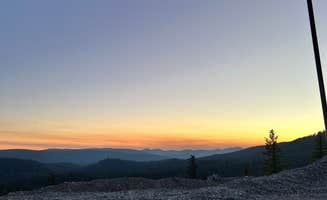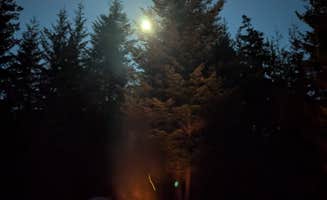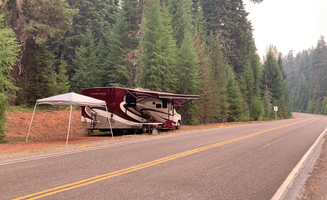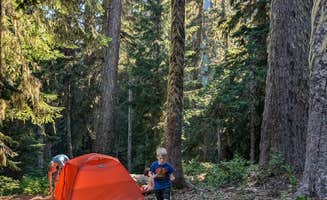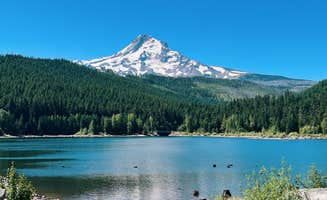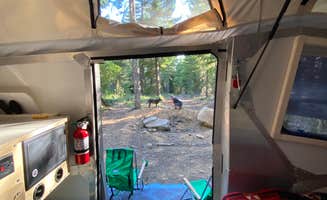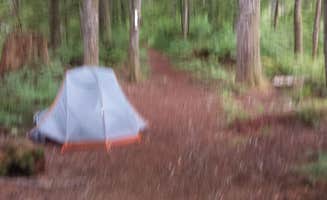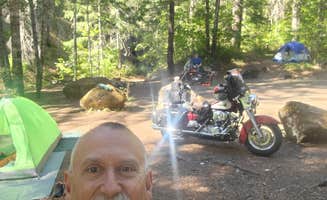Mount Hood National Forest offers numerous rustic camping near Estacada, Oregon throughout its 1.1 million acres. The area features elevations ranging from 1,500 to over 6,000 feet, creating diverse microclimates across different camping zones. Summer temperatures typically range from 50-85°F with cooler nights at higher elevations, while seasonal road closures affect accessibility from November through April.
What to do
Hiking to alpine views: The McNeil Point Dispersed Camping area provides access to expansive vistas along the Timberline Trail. "We began this trek at the Lolo Pass Trailhead, which is part of the Pacific Crest Trail and lead to the Timberline Trail. We then followed the Timberline Trail to our destination, McNeil Point," notes Molly Y., who adds that "The trail to McNeil Point is mainly uphill with many switchbacks. As you hike you will travel through a variety of terrain and flora."
Creek exploration: Visit Little Soda Springs Rd Dispersed for water-based activities. "It's a short hike down to the creek. It looks like there might be two walk-in campsites as well and I believe there might be one if you walk across the Creek," shares Vanessa T. The creek provides opportunities for wading and cooling off during summer months.
Stargazing opportunities: The clear mountain air makes night sky viewing exceptional at higher elevation sites. Julie H. reports from Mount Hood dispersed camping: "The night sky was insane here. Pre-established fire pits everywhere too. 2 bars LTE on Verizon enough to make calls and the guys to play video games." Light pollution is minimal at most forest sites, particularly on weeknights.
What campers like
Solitude at higher elevations: McNeil Point Dispersed Camping offers isolation even during busy seasons. Kennedy F. explains: "I ended up camping at the point rather than further down, which was a challenge to carry my pack up, but so worth it in my opinion. It's dispersed camping so solitude is easily reachable considering not too many people stay the night."
Off-season accessibility: Some areas remain open for adventurous winter camping. Taylor K. notes: "Went snowshoe backpacking up to McNeil Point this weekend and camped and showshoe-d around the area for a few days. This area is extremely popular in summer and is along the Timberline Trail, but during our Late May excursion there was still tons of snow and only saw a few people in the 3 days we were up there."
Alternative to crowded sites: Pioneer Bridle Trail Camp offers easier-to-access options when main campgrounds fill up. "This was a super cute and super easy to find spot right off the highway near Government Camp. We had a larger group, so we took the very first spot which had a large flat area and a fire circle, but there were more secluded spots further down the road," reports Emma P.
What you should know
Road conditions vary significantly: Many secondary forest roads require appropriate vehicles. Caroline E. advises when visiting Mount Hood National Forest - NF 2656: "Definitely download the mvum from Avenza beforehand to make things easier. Road can be rough in some places but 4WD not necessary. Not many pull-in camping spots so you'll have to search around."
Seasonal closures affect access: Winter conditions limit entry to many dispersed sites. "Looking forward to camping here, but the whole road is closed for the foreseeable future due to the fires," notes Jennifer R. about Trillium Sno-Park. Always check current Forest Service road closures before planning a trip.
Water availability is limited: Most primitive sites require bringing all water or filtering from natural sources. One camper at Mirror Lake advises: "Bring water filtrations or extra water since there is no water up there besides the lake." Natural water sources may be seasonal or contaminated.
Tips for camping with families
Consider shorter backpacking routes: Mirror Lake offers manageable trails for families with children. "Its only ~3 mile hike in, so highly recommend anyone from beginner to expert backpacking to come checkout the campsites," suggests Sonja O. The relatively flat trail makes it accessible for older children carrying light packs.
Watch for uneven terrain: Many dispersed sites lack level tent pads. Garrett B. noted at White River West Sno-Park: "This is a large, paved parking lot with a stream nearby. Has a good view of Mt. Hood and vault toilets, so that's a positive. The downside is that it's not level. Trailers shouldn't have a problem, but even with several blocks under our tires, our 39ft Class A was still un-level."
Pack extra clothes: Temperature fluctuations can be significant, especially at higher elevations. "The temperature was about 30-40 degrees Fahrenheit overnight, so don't forget a hat!" advises Molly Y. about camping at McNeil Point.
Tips from RVers
Choose designated dispersed areas: Trillium Lake Airstrip Dispersed provides suitable spots for larger vehicles. "Lots of room for any size rig. Remember when you turned into the airstrip, take a left in one of the access points. There are a few areas on the right side of the road. Though I would suggest parking in the airstrip and walking it first. That way you know your Strategy," recommends Kevin L.
Bring leveling equipment: Uneven terrain requires preparation. Lynne R. shares from Trillium Lake Airstrip: "For a free place to stay it sure beats a parking lot. Lots of trees, large spaces but lots of rain in May. But if coming thr again I would stay here. You can stay up to 14 days."
Plan for weather changes: Mountain weather systems move quickly. Multiple reviewers noted experiencing all types of weather in single stays. One camper reported: "We stayed 5 nights, had all types of weather on our stay, from lots of rain to sun and also snow."



